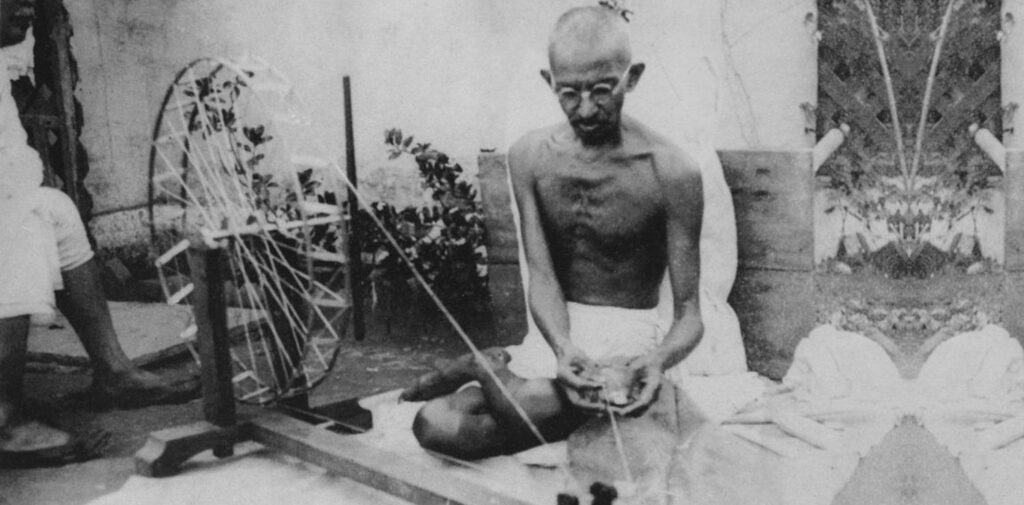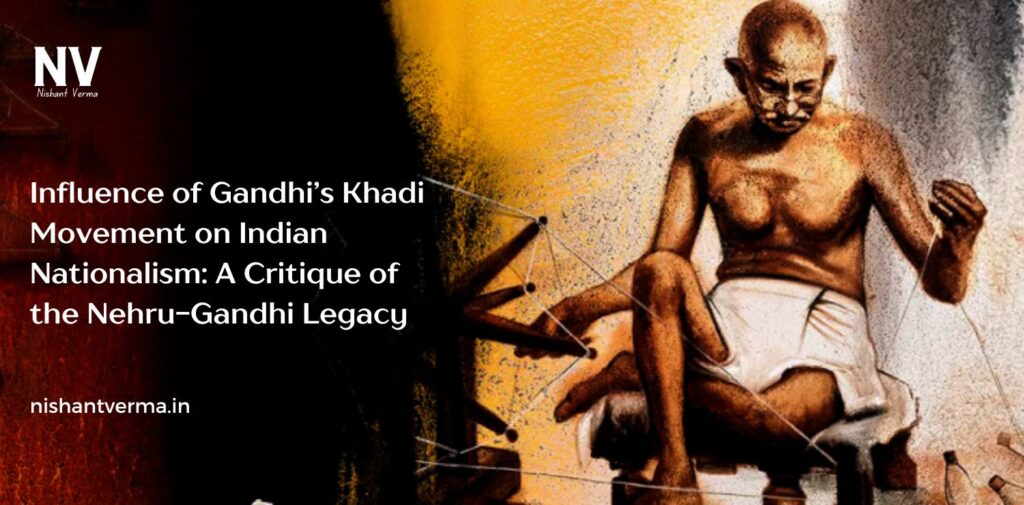The Khadi Movement, led by Mahatma Gandhi, is often remembered as one of the most iconic symbols of India’s struggle for independence. For many, it is seen as a powerful symbol of self-reliance and resistance to British colonial rule. The spinning of khadi (handwoven cloth) became a patriotic act, representing the rejection of foreign goods and the assertion of India’s cultural and economic independence. However, while the Influence of Gandhi’s Khadi Movement on Indian Nationalism, it is important to critically examine the long-term consequences of this movement, particularly in relation to the leadership of the Nehru-Gandhi family.
While Gandhi’s leadership is credited with shaping India’s independence struggle, his influence on the future of India—especially in terms of economic policies and industrialization—was more complicated. The legacy of the Nehru-Gandhi family in post-independence India has often overshadowed other, more holistic contributions made by leaders from different walks of life. The focus on Khadi and the rural self-sufficiency model, championed by Gandhi, was important in galvanizing the masses during the freedom struggle, but it has left an enduring, limiting impact on India’s economic development. Let’s delve into the influence of the Khadi Movement on Indian nationalism, and also explore why it is essential to critique the legacy of the Nehru-Gandhi family in shaping modern India.
Gandhi’s Khadi Movement and the Symbol of Self-Reliance
The Khadi Movement emerged as a direct response to British colonial policies that sought to de-industrialize India and make it dependent on British goods. The British had destroyed India’s flourishing textile industry by imposing heavy tariffs on Indian products while flooding the Indian market with cheap machine-made goods from Britain. This economic exploitation deeply affected India’s artisans and workers, especially those in the textile sector.
Mahatma Gandhi’s idea of spinning khadi (handwoven cloth) became a revolutionary act. For Gandhi, khadi was not just a fabric; it symbolized self-sufficiency, pride in Indian traditions, and a rejection of British rule. It was a call for the people of India to become self-reliant, both in terms of their economy and culture, to free themselves from the shackles of colonial exploitation.
The Khadi Movement was an essential part of Gandhi’s larger philosophy of non-violence (ahimsa) and satyagraha (truth-force), which aimed at attaining independence through peaceful means. By encouraging people to spin their own clothes, Gandhi wanted to create economic and cultural self-reliance while simultaneously weakening the British economy. This simple act of spinning khadi became a powerful tool for unity in India’s diverse and fragmented society, drawing people from all walks of life into the freedom movement.

The Rise of Khadi as a Symbol of Nationalism
The Khadi Movement quickly became an emblem of Indian nationalism. Wearing khadi, particularly during the Civil Disobedience Movement and the Salt March, was a way for Indians to show their rejection of British colonial control. Khadi became a way to assert India’s independence, not only politically but also economically. By rejecting foreign cloth, Indians were making a statement of unity and resistance against the exploitation of their resources by the British.
Furthermore, khadi became a way to connect the rural and urban populations in the nationalist struggle. Gandhi’s emphasis on rural self-sufficiency and his call for khadi manufacturing as an industry for villages bridged the urban-rural divide. It gave rural populations, often marginalized in the political landscape, a central role in the fight for freedom. The Khadi Movement provided a way for even the poorest Indians to contribute to the national struggle, making it a movement that truly belonged to the masses.
Gandhi’s call to boycott foreign goods also served as a unifying force for the different regional and cultural groups within India. People from various states, castes, and communities came together in their support of khadi, and the spinning wheel became a powerful symbol of India’s unity. Khadi represented more than just economic resistance to the British; it became a cultural revolution, promoting indigenous craftsmanship and reawakening national pride in India’s heritage.

The Limitations and Consequences of the Khadi Movement
While the Khadi Movement had undeniable significance in the independence struggle, its legacy is more complicated when examined through the lens of post-independence India. Gandhi’s emphasis on self-sufficiency, particularly in the context of Khadi, was rooted in an idealistic vision of rural India. He believed that India’s future lay in its villages, and khadi was seen as a means of restoring rural vitality and reducing dependence on foreign goods. However, this vision did not account for the complexity of modern economic needs.
Economic Stagnation Due to Overemphasis on Khadi
The idea of economic self-sufficiency through khadi has been criticized for hindering India’s industrial growth in the years following independence. Gandhi’s focus on handicrafts and rural industries created a cultural and economic environment where industrialization was seen as unnecessary or even undesirable. This sentiment continued even after independence, largely influenced by Gandhi’s principles.
When Jawaharlal Nehru became the first Prime Minister of India, his economic policies, though progressive in some ways, continued to be influenced by Gandhi’s ideal of self-reliance. While Nehru’s industrial policies led to the creation of some important public sector industries, the emphasis on rural self-sufficiency and khadi remained entrenched. This imbalance between promoting modern industry and focusing on the rural sector led to a situation where India remained economically underdeveloped for several decades.
The Nehru-Gandhi Family’s Elitism and Disconnect from the Grassroots
The Nehru-Gandhi family, despite their ties to the freedom struggle, have often been criticized for their elitism and their disconnect from the realities faced by ordinary Indians after independence. Jawaharlal Nehru, despite his advocacy for modern science and technology, failed to push for the comprehensive industrial revolution that India needed to become a global economic power. Instead, Nehru’s policies favored large public-sector enterprises and heavy industrialization, which often ignored the needs and aspirations of the rural poor.
The Gandhi family’s political legacy, which has continued through Indira Gandhi and Rajiv Gandhi, has also been marred by their centralization of power and the dynastic nature of Indian politics. While they may have sought to address the problems of rural India, their policies often left much to be desired in terms of creating lasting, meaningful change at the grassroots level. The focus on symbolic gestures, such as khadi, at times obscured the more pressing need for infrastructural development, education, and technological innovation in rural areas.

Khadi as a Political Tool Rather than a Sustainable Solution
Over time, the Khadi Movement became less about economic self-reliance and more about political symbolism. While it served as an excellent tool for mobilizing people during the freedom struggle, khadi’s relevance in a post-independence world became questionable. After India achieved independence, the focus shifted to larger economic issues, including the need for modernization, industrialization, and global integration. Despite its initial importance, the emphasis on khadi as a symbol of self-reliance seemed outdated in a rapidly changing world.
The leaders of the Nehru-Gandhi family, despite their significant political power, did little to transform the Khadi Movement from a symbolic act into a truly sustainable and viable economic model for India. The continued political emphasis on khadi as a representation of India’s struggle for freedom sometimes overshadowed the more urgent need to create a modern, diversified economy.
Conclusion: Khadi Movement on Indian Nationalism
The Khadi Movement was undoubtedly a significant part of India’s independence struggle. It united people across regions and classes, gave them a tangible way to participate in the nationalist movement, and became a powerful symbol of resistance against British colonialism. However, the overemphasis on khadi, particularly by the Nehru-Gandhi family in the years following independence, has had long-lasting consequences for India’s economic development.
While Gandhi’s ideals of self-sufficiency and rural empowerment were noble, they did not adequately address the challenges of modernizing India’s economy. The Nehru-Gandhi family’s focus on symbols like khadi, instead of embracing a more balanced and forward-looking economic strategy, has often been criticized for hindering India’s industrial and technological growth.
To truly honor the legacy of India’s freedom struggle, it is important to acknowledge the limitations of the Khadi Movement and to critically examine the long-term consequences of the Nehru-Gandhi family’s policies on India’s economic trajectory. India’s independence was not just about rejecting foreign rule but also about embracing a future of prosperity and self-reliance—something that requires a more inclusive and forward-thinking approach than the one advocated by Gandhi and continued by the Nehru-Gandhi family.




